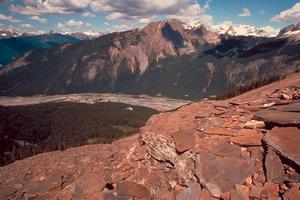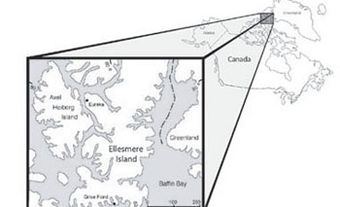The first animals were microscopic in size and left no known FOSSIL remains. The oldest animal fossils occur in sediments deposited under shallow equatorial seas over 600 million years ago. Probably less than 100 species are known, most being JELLYFISH and leaflike, soft CORALS. These fed on microscopic organisms filtered from seawater, while less abundant, wormlike animals sifted organic debris from soft sediments on the seafloor. The most important fossil sites in the Western Hemisphere, both for their great age and the relatively deepwater environments they represent, are located on the AVALON PENINSULA, Newfoundland.
History
By 500 million years ago, primitive jointed-legged animals (eg, TRILOBITES) were abundant in the seas, together with small, shelled animals and primitive, noncoralline, reef-forming organisms. The BURGESS SHALE, a UNITED NATIONS WORLD HERITAGE SITE in YOHO NATIONAL PARK, has yielded superbly preserved fossils of archaic soft-bodied animals, buried in fine-grained mudstones at the base of a tropical algal reef. Approximately 140 species have been identified at this site alone, including antecedents of backboned animals. It is the most diverse fauna known for this time. The nutrient-rich coastal margins of shallow equatorial seas provided a centre of origin for new kinds of marine animals, which usually displaced the more primitive forms toward the ocean basins. Accordingly, about 450 million years ago, the trilobite faunas were displaced by shallow-water communities dominated by primitive corals, lamp shells, sea lilies and straight-shelled MOLLUSCS. Their fossil remains are found in flat-lying marine limestones, shales and sandstones throughout Canada.
An extinction interval occurred approximately 435 million years ago, coinciding with the spread of continental ice sheets over what has become the Sahara Desert, and the withdrawal of shallow seas from the continents. However, representatives of most major groups of marine organisms survived and repopulated the seas. The Hagersville site, Ontario, containing large, shallow marine shellfish is dated at 380 million years old.
A symbiosis between FUNGI and green ALGAE gave rise to the land PLANTS, which spread across fertile DELTAS and coastal lowlands 410 million years ago. Terrestrial ARTHROPODS also appear in the record at this time. About 350 million years ago, a brackish water lagoon near Miguasha, Québec (see MIGUASHA FOSSILS). was the burial site of outstandingly preserved specimens of about 2 dozen species of lungfish and lobe-finned FISHES. Among them are the remains of the oldest known AMPHIBIANS. Another profound extinction of unknown cause occurred shortly thereafter.
By 300 million years ago, the major groups of marine animals were again highly diverse. The oldest, truly terrestrial, backboned animals were lizardlike REPTILES, whose skeletons are preserved in still-standing hollow tree trunks, buried in sediments now exposed in the sea cliffs near JOGGINS, NS. These reptiles fed on arthropods, initiating an ecological relationship between the 2 major groups of terrestrial animals which has continued to the present. Backboned animals did not begin to feed directly on land plants until 20 million years later. From this period on, the number of major groups of terrestrial animals was at least half that of major groups of marine animals. Fossils of primitive, mammallike reptiles estimated to be about 275 million years old are found on ancient semiarid deltas at CHARLOTTETOWN, PEI.
The greatest recorded mass extinction occurred about 230 million years ago. It has been estimated that 90% of marine animal species disappeared, and major groups were unable to regain their former importance. Land animals were reduced similarly. The extinctions have been linked to the coalescence of continental blocks into a single super-continent, although the brevity of these extinction intervals is seen by some to be incongruent with ponderous continental movements. Marine faunas, hereafter, were characterized by an abundance of molluscs, arthropods and bony fishes; on land, large reptiles close to the ancestry of mammals were replaced by reptiles related to crocodiles. As during other extinctions, small insectivorous, backboned animals did not seem to suffer as greatly as many of their larger relatives.
Another less severe extinction occurred 195 million years ago. Crocodilelike terrestrial faunas were then replaced by communities dominated by MAMMALS and DINOSAURS. Mammals were small during the period of dinosaurian ascendancy and probably possessed high metabolic rates in relation to their body size. These rates enabled insectivorous mammals to match activity levels sustained by INSECTS as a consequence of their still smaller body size. Primitive BIRDS, descended from small carnivorous dinosaurs, are also presumed to have had high metabolic rates. Conversely, herbivorous dinosaurs became large, in part as a result of economies gained by a relative decrease in the effort required for locomotion and a reduced basal metabolic rate associated with increased body mass. They were energy-efficient browsers of bulk vegetation. The largest and most diverse assemblage of dinosaurs known is represented by skeletons preserved in the badlands of DINOSAUR PROVINCIAL PARK, Alberta, another UN World Heritage Site. More than 300 specimens belonging to 31 species have so far been collected. The wealth of fossil materials has served as a basis for studies on dinosaurian ecology of about 75 million years ago.
About 65 million years ago, a mass extinction abruptly eliminated the dinosaurs and an estimated three-quarters of then living species. The extinctions are associated with a chemical anomaly in the sediments of the time which suggests the impact of an asteroid. The Marine molluscs, arthropods and bony fishes soon regained and surpassed their former levels of diversity. By 50 million years ago, Earth had ceased to be predominantly a water world, as many vital substances were captured and retained in terrestrial ECOSYSTEMS. Birds and mammals diversified on land, their generally smaller body sizes favouring the existence of a larger number of species than was the case in dinosaurian faunas. Fossils of early mammals, turtles and crocodiles in warm, broadleaf forests estimated to be about 50 million years old occur on ELLESMERE ISLAND, NWT (see also see alsoELLESMERE ISLAND PLIOCENE FOSSILS. In the CYPRESS HILLS, Saskatchewan, an abundant and diversified fauna of large, fossil mammals (about 35 million years old) occurs. The ancestors of man appeared in equatorial regions of Africa and Asia about 3 million years ago. In the OLD CROW BASIN, YT, 25 000-30 000-year-old fossils of Ice Age mammals and early man are found in unglaciated terrain.
During the past 400 million years, arthropods have dominated land faunas in number of species and individuals, and in the volume of organic material consumed. This domination is now being challenged by one uniquely successful species of backboned animal, Homo sapiens, which has acquired a highly complicated brain giving it an enormous selective advantage.
Unexplored Record
The fossil record retains an enormous amount of unexplored and interesting information on the EVOLUTION of animal life. It can reveal the physical or biological conditions that will produce evolutionary stagnation or evolutionary acceleration. The record will provide the means to measure the progress of trends such as the differentiation of primitive, segmented worms into more complex organisms such as butterflies and birds; the development of simple communities dominated by archaic jellyfish into the intricate animate realms of modern coral reefs; and the appearance of similar structures in unrelated animals (eg, the brain in an octopus and an owl). The record will also have important implications for the study of the evolution of animate organisms in extraterrestrial worlds. It will show whether mass extinctions stimulate evolution toward higher levels of animal complexity or the converse. The record of animal life on Earth should provide a framework for projecting its evolution into the next few million years.
In a general way, the specialization of animal structures and multiplication of animal species have been stimulated by competition in the struggle for existence. Thus the rate at which the number of animal species increased, over periods of tens of millions of years, has been approximately proportional to the number of species in existence. The total number of species present on Earth, accordingly, tends to grow ever more rapidly. In a similar manner, humanity's most valuable competitive asset, its brain, has evolved according to a pattern that suggests that the rate of increase in brain size is proportional to brain size. This implies that competition between individuals of our species generates the selective pressure in brain evolution, and increase in brain size should continue.
A long-term trend toward an increase in the variety and complexity in animal life has been interrupted periodically by shorter intervals marked by severe extinctions. The causes of individual mass extinctions may differ. Mankind is clearly implicated in the extinctions that began toward the end of the last ICE AGE (10 000 years ago) and which continue today. After earlier mass extinctions, the few surviving organisms soon differentiated into an array of different species, which developed many modifications of the successful ancestral body plan. Perhaps our species is the primitive stem of a new kind of animal, the intellectual qualities of which will differentiate and expand into another array of different and increasingly complex animals in the history of terrestrial life.

 Share on Facebook
Share on Facebook Share on X
Share on X Share by Email
Share by Email Share on Google Classroom
Share on Google Classroom





